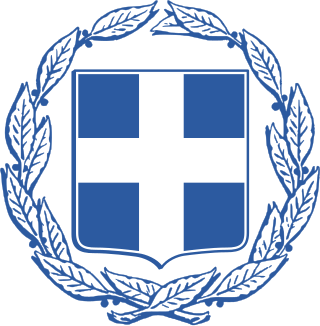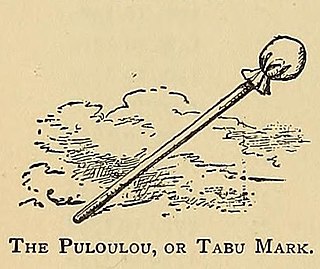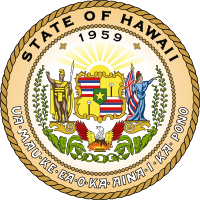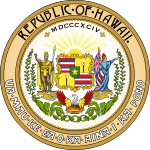
The coat of arms of South Africa is the main heraldic insignia of South Africa. The present coat of arms was introduced on Freedom Day, 27 April 2000, and was designed by Iaan Bekker. It replaced the earlier national arms, which had been in use since 1910. The motto is written in the extinct |Xam, member of the Khoisan languages, and translates literally to "diverse people unite". The previous motto, in Latin, was Ex Unitate Vires, translated as "From unity, strength".

A coat of arms is a heraldic visual design on an escutcheon, surcoat, or tabard. The coat of arms on an escutcheon forms the central element of the full heraldic achievement, which in its whole consists of a shield, supporters, a crest, and a motto. A coat of arms is traditionally unique to the armiger. The term 'coat of arms' itself, describing in modern times just the heraldic design, originates from the description of the entire medieval chainmail 'surcoat' garment used in combat or preparation for the latter.

The Arms of Canada, also known as the Royal Coat of Arms of Canada or, formally, as the Arms of His Majesty the King in Right of Canada, is the arms of dominion of the Canadian monarch and, thus, also the official coat of arms of Canada. In use since 1921, it is closely modelled after the royal coat of arms of the United Kingdom, with French and distinctive Canadian elements replacing or added to those derived from the British version.

The coat of arms of Nova Scotia is the heraldic symbol representing the Canadian province of Nova Scotia. It is the oldest provincial achievement of arms in Canada, and the oldest British coat of arms in use outside Great Britain. It is blazoned as follows: Argent, a saltire azure charged with an escutcheon of the Royal Arms of Scotland.

The coat of arms of the Philippines features the eight-rayed sun of the Philippines with each ray representing the eight provinces which were placed under martial law by Governor-General Ramón Blanco Sr. during the Philippine Revolution, and the three five-pointed stars representing the three major island groups of Luzon, the Visayas, and Mindanao.

The coat of arms of British Columbia is the heraldic symbol representing the Canadian province of British Columbia. The arms contains symbols reflecting British Columbia's British heritage along with local symbols. At the upper part of the shield is the Union Jack, representing the United Kingdom. The lower portion of the shield features a golden sun setting into the ocean, representing the province's location on the Pacific.

The coat of arms of Ukraine is a blue shield with a golden trident. Officially referred to as the Emblem of the Royal State of Volodymyr the Great, or, colloquially, the tryzub, the insignia derives from the seal-trident of Volodymyr the Great, the first Grand Prince of Kyiv.

The coat of arms of the Kingdom of the Netherlands was originally adopted in 1815 and later modified in 1907. The arms are a composite of the arms of the former Dutch Republic and the arms of the House of Nassau, it features a checkered shield with a lion grasping a sword in one hand and a bundle of arrows in the other and is the heraldic symbol of the monarch and the country. The monarch uses a version of the arms with a mantle while the government of the Netherlands uses a smaller version without the mantle (cloak) or the pavilion, sometimes only the shield and crown are used. The components of the coats of arms were regulated by Queen Wilhelmina in a royal decree of 10 July 1907, affirmed by Queen Juliana in a royal decree of 23 April 1980.

The coat of arms of Georgia is one of the national symbols of Georgia. The coat of arms is partially based on the medieval arms of the Georgian royal house and features Saint George, the traditional patron saint of Georgia. In addition to St. George, the original proposal included additional heraldic elements found on the royal seal, such as the seamless robe of Jesus, but this was deemed excessively religious and was not incorporated into the final version.

The coat of arms of Greece or national seal of Greece comprises a white Greek cross on a blue escutcheon, surrounded by two laurel branches. It has been in use in its current form since 1975. Prior to the adoption of the current coat of arms, Greece used a number of different designs, some of which were not heraldic; the first heraldic design was introduced in 1832 and its main element, the blue shield with the white cross, has been the base for all other national coats of arms since then. The design is a heraldic representation of the Greek national flag adopted in 1822, which featured a white cross on a blue field.

Portuguese heraldry encompasses the modern and historic traditions of heraldry in Portugal and the Portuguese Empire. Portuguese heraldry is part of the larger Iberian tradition of heraldry, one of the major schools of heraldic tradition, and grants coats of arms to individuals, cities, Portuguese colonies, and other institutions. Heraldry has been practiced in Portugal at least since the 12th century, however it only became standardized and popularized in the 16th century, during the reign of King Manuel I of Portugal, who created the first heraldic ordinances in the country. Like in other Iberian heraldic traditions, the use of quartering and augmentations of honor is highly representative of Portuguese heraldry, but unlike in any other Iberian traditions, the use of heraldic crests is highly popular.

Thomas Square is a park in Honolulu, Hawaii, named for Admiral Richard Darton Thomas. The Privy Council voted to increase its boundaries on March 8, 1850, making Thomas Square Hawaii's oldest city park. It is one of four sites in Hawaii where the Hawaiian flag is allowed to fly alone without the United States flag.

The Paulet affair, also known as British Hawaii, was the unofficial five-month 1843 occupation of the Hawaiian Islands by British naval officer Captain Lord George Paulet, of HMS Carysfort. It was ended by the arrival of American warships sent to defend Hawaii's independence. The British government in London did not authorize the move and it had no official status.

Ua Mau ke Ea o ka ʻĀina i ka Pono is a Hawaiian phrase, spoken by Kamehameha III, and adopted in 1959 as the state motto. It is most commonly translated as "the life of the land is perpetuated in righteousness." An alternative translation, which appears at Thomas Square next to a statue of Kamehameha III, is "The sovereignty of the kingdom continues because we are righteous."
A national coat of arms is a symbol which denotes an independent state in the form of a heraldic achievement. While a national flag is usually used by the population at large and is flown outside and on ships, a national coat of arms is normally considered a symbol of the government or the head of state personally and tends to be used in print, on armorial ware, and as a wall decoration in official buildings. The royal arms of a monarchy, which may be identical to the national arms, are sometimes described as arms of dominion or arms of sovereignty.

Sovereignty Restoration Day is a national holiday of the former Hawaiian Kingdom celebrated on July 31 and still commemorated by Native Hawaiians in the state of Hawaii. It honors the restoration of sovereignty to the kingdom, following the occupation of Hawaiʻi by Great Britain during the 1843 Paulet Affair, by British Rear-Admiral Richard Darton Thomas and when King Kamehameha III uttered the phrase: Ua Mau ke Ea o ka ʻĀina i ka Pono.

The Kalākaua coinage is a set of silver coins of the Kingdom of Hawaii dated 1883, authorized to boost Hawaiian pride by giving the kingdom its own money. They were designed by Charles E. Barber, Chief Engraver of the United States Bureau of the Mint, and were struck at the San Francisco Mint. The issued coins are a dime, quarter dollar, half dollar, and dollar.

Pūloʻuloʻu, often called "kapu sticks", are symbols denoting the kapu of Hawaiian aliʻi and symbolizing the deceased ancestors of the aliʻi. They are traditional symbols of authority which are used in modern times including the Seal of the State of Hawaii.

The coat of arms of the Hawaiian Kingdom was officially adopted by the Legislative Assembly in 1845, during the reign of King Kamehameha III. The arms were designed by King the "Portcullis", from the College of Arms in London, commissioned by Timoteo Ha‘alilio, the King's private secretary and Royal Advisor, Reverend William Richards.




























